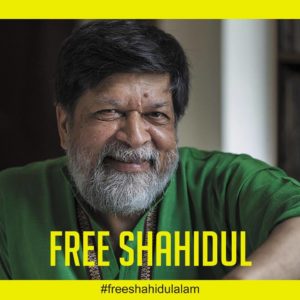
Free Dr. Shahidul Alam: The Guardian / British Journal of Photography
Musings by Shahidul Alam

Free Dr. Shahidul Alam: The Guardian / British Journal of Photography
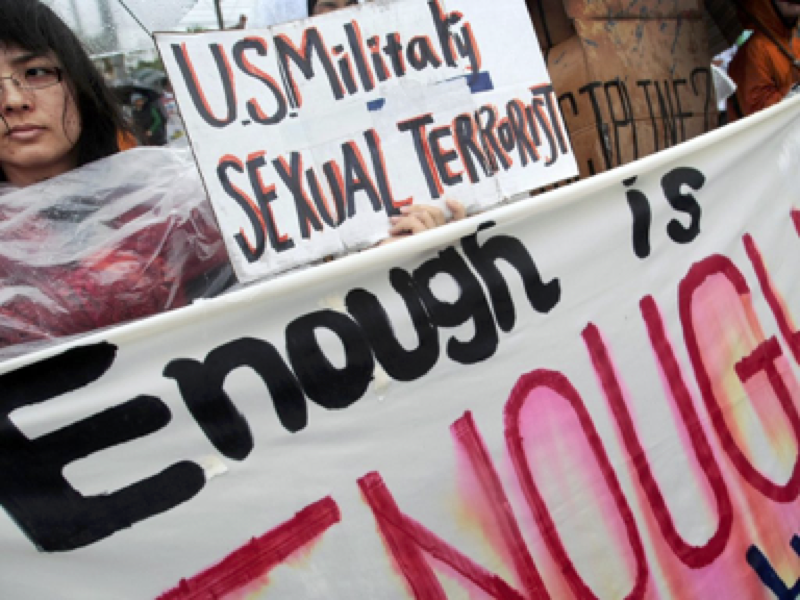
by an American serviceman in Okinawa islands, southwestern Japan.
March 23, 2008. AP Photo/Itsuo Inouye
By Rahnuma Ahmed
For the military-industrial complex named the United States, Okinawa is a ‘hub’ for conducting strategic operations throughout the Pacific, but for its residents, US military bases seem to be a hub which harbours ‘sexual terrorists.’
As Okinawan resistance to the US bases lengthens, as our knowledge of the workings of the ‘garrisoning of the globe’ (Chalmers Johnson) deepens, it is not surprising that several authors have likened the US military to the ISIS (or ISIL, Islamic State of the Iraq and the Levant).
Matt Pepe writes, ‘One of the strongest condemnations of terrorist groups like ISIS?rightly so?is that they exploit women for sex. Examination of the U.S. military’s history abroad reveals a track record of similar sexual abuse of local women and girls.’ US soldiers had told David Vine, author of Base Nation, that their coworkers had bought women as ‘sex slaves.’
Such information, of course, is hard to come by in the Western mainstream media.
Women’s bodies cemented military alliances
The United States has a global network of 800 military installations around the world; the emergence of the bases were accompanied by the development of ‘commercial sex zones.’ Most of theses bases resemble each other, writes Vine, ‘filled with liquor stores, fast-food outlets, tattoo parlors, bars and clubs, and prostitution in one form or another. The evidence is just outside the gates in places such as Baumholder and Kaiserslautern in Germany, and Kadena and Kin Town in Okinawa.’
When the Second World War came to an end, the behaviour of American troops became a matter of concern. They were behaving ‘as though Koreans were a conquered nation rather than a liberated people.’ Although this eventually led to a ‘hands off Korean women’ policy, it excluded women in brothels, dance halls and those working in the streets. The Japanese had forced hundreds of thousands of women from Korea, China, Okinawa, rural Japan, and other parts of Asia into sexual slavery, known as the ‘comfort stations’ system. After the US occupied present-day South Korea (1945-1948), American military authorities took over some of the ‘comfort stations’ with the assistance of Korean officials (paradoxically, the issue of ‘comfort women’ is still a contentious issue between the Koreans and the Japanese).
According to a 1965 survey, 85% of GIs either had ‘been with’ or had ‘been out with’ a prostitute. Although the formal system of sexual slavery came to an end after the Second World War, Vine cites an American military chaplain who had commented, ‘Many men have their steadies. Some of them own their girls, complete with hooch [small house] and furniture. Before leaving Korea, they sell the package to a man who is just coming in’ (emphasis in original).
After US military bases were installed in South Korea in the 1950s, settlements known as ‘camptowns’ emerged close by; more than 150,000 Korean women, lacking any other economic alternative, took up sex work. Many of them were later subjected to severe social stigmatisation, and forced into destitution. While some would argue that the ‘supply emerged to meet a market demand’, Pepe caustically notes, military bases are not a product of the free market, they are ‘imposed without consent on communities where they dominate the local economies’ thwarting the ‘possibilities of independent development.’
Camptowns and prostitution were foreign currency-earners for Korea’s cash-strapped, war-ravaged economy, writes Vine; government documents reveal South Korean officials strategising on how to ‘encourage GIs to spend their money on women in Korea rather than Japan’ during their official leave, on offering classes in basic English and etiquette to women. Aeran Kim, a former sex worker recalls, ‘They urged us to sell as much as possible to the GI’s, praising us as ‘dollar-earning patriots.’ Our government was one big pimp for the U.S. military.’
Another sex-worker, who refused to be identified, said, ‘Women like me were the biggest sacrifice for my country’s alliance with the Americans. Looking back, I think my body was not mine, but the government’s and the U.S. military’s.’
Okinawa as America’s ‘strategic frontier’
Okinawa Island (part of the larger Ryukyu Islands group) was described by Douglas Mac Arthur, the famous five-star general of the US Army, as the ‘island-bastion’ of America’s ‘strategic frontier‘ on the eastern coast of the Asian continent.
The presence of hundreds of military bases had marked the American occupation of Japan (1945-1952) after its defeat in the Second World War. These were closed down after the normalisation of relations on the condition that their functions would be transferred to Okinawa. Mainland Japan had agreed; since then, Okinawa has borne the brunt of serving American and Japanese strategic interests.
Taipei, Shanghai, Hong Kong, Seoul, Manila, Tokyo?all lie within a 1500 kilometre radius, ‘If there is a trouble spot in the Pacific and the Department of Defense needs to move forces quickly, Okinawa [has] the facilities to support that response’ (globalsecurity.org).
Okinawa, which is only 0.6% of the land mass of Japan, hosts 75% of all US bases in the country. Of the 32 military bases located on the Ryukyu Islands, 20 are on the main island of Okinawa, occupying 20% of the island; there are also 48 restricted air and ocean training sites on the island. Almost half of US forces, nearly 26,000 military personnel, are stationed in Okinawa.
The Kadena Air Base was used for B-29 bombing missions during the Korean War (1950-1953); it was a major staging area throughout the Vietnam War (1955-1975); troops stationed in Okinawa were deployed to the Persian Gulf in the 1990s; weapons used in the invasion and occupation of Afghanistan and Iraq were stored and transported from Okinawa’s military bases.
One thousand nuclear warheads were deployed in Okinawa; this was acknowledged (and removed) only before the US returned Okinawa to Japan, after a 22-year long US occupation (1950-1972). But since US military presence remained intact, the occupation of Okinawa continues. As Richard Falk puts it, it is a colony in a post-colonial era, subjugated to ‘pursuing the Asian strategic interests of the United States.’
A ‘sordid history’ and ‘deepest regrets’
It was September 4, 1995, about 8:00 pm. A 12-year-old Okinawan schoolgirl was abducted by two Marines (Pfc. Rodrico Harp, 21, and Pfc. Kendrick M. Ledet, 20) and a Navy Seaman (Marcus D. Gill, 22).
According to Harp’s attorney, Mitsonobu Matsunaga, the three men went out to buy sex but decided on rape instead ‘because one of them did not have enough money’ (www.latimes.com, October 28, 1995).
Gill had rented a car, he picked up Harp, Ledet and another servicemen, after having lunch, they drove around all afternoon, but when Gill spoke of rape, the fourth man declined and left the group. Harp and Ledet had nearly $30, but Gill said he was broke, and anyway, paid sex was ‘no fun.’ He proposed rape. He had come prepared with duct tape and condoms.
When the three servicemen saw a Japanese girl wearing a school uniform with a bag of books, they stopped the car, pulled her inside, put her in the back seat, taped her mouth and eyes, and bound her hands and legs. They drove to a secluded field, parked the car, Gill, who was described as a ‘tank’?6 feet tall, weighing 260-270 pounds?got out, and went into the back seat. He ”violently’ beat the struggling schoolgirl, telling her to ‘let me do what I want to do.”
The victim insisted on reporting it to the police, she didn’t want it to happen to another girl. The incident provoked the largest demonstration against US military bases in the history of Okinawa, drawing nearly 100,000 protestors.
The US invoked Article 17 of the SOFA (Status of Forces Agreement) regarding jurisdiction over US military personnel, and refused to surrender the three suspects to the Japanese authorities. It led protestors to demand that the two governments revise the security treaty, and the SOFA; some argued for their cancellation.
The commander of US forces in the Pacific Admiral Richard C. Macke told defence writers, ‘For the price they paid to rent the car they could have had a girl.’
More recently, the Associated Press (AP) obtained more than 1,000 internal Department of Defense documents, through a Freedom of Information Act (FOIA) request. The documents, detailing investigations of sex crimes from 2005 to early 2013, involving U.S. military personnel stationed in Japan, reveal a ‘sordid history.’ ‘[M]ost offendors were not incarcerated, suspects received light punishments after being accused of serious violations, and victims increasingly were wary of cooperating with investigators’ (www.capitolhillblue.com, February 9, 2014).
Light punishments were ‘non-judicial penalties’, ranging from offendors being ‘fined, demoted, restricted to their bases or [being] removed from the military.’ In 30 cases, only a letter of reprimand was issued. In 46 Marine, and 22 Navy, cases, personnel who had initially been accused of a ‘violent sex crime’ were punished for nonviolent or nonsexual offenses, such as, assault, failure to obey, adultery, having sex in barracks and fraternization. In two rape cases, the charges were dropped after the commanders overruled recommendations for courts martial. In sum, allegations were handled chaotically, and judgments were ‘random.’
The documents also show a pattern found in US bases elsewhere, US troops who ‘commit sexual assaults are most likely to abuse their fellow troops.’
US president Barack Obama’s official visit to Japan in May 2016 was overshadowed by the slaying of an Okinawan woman, Rina Shimabukuro, by a former US marine and current civilian worker, Kenneth Franklin Shinzato. Obama offered his ‘sincere condolences and deepest regrets.’
Media reports of the AP investigation led USA’s elected representatives to insist on the need for ‘further changes in the military’s legal system.’ It caused military officials to reiterate that ‘numerous changes [were being made to] military law and policy’ to ensure that allegations would be taken ‘seriously’, that the perpetrators would be ‘punished’.
‘Sensitivity training’ or structural violence?
A women’s movement demanding peace, human rights, and demilitarisation was formed in September 1995 after the rape of the 12-year-old scholgirl. The Okinawa Women Act Against Military Violence (OWAAMV) has concentrated on analysing the consequences of ‘long-term active foreign military occupation.’
Kozue Akibayashi and Suzuyo Takazato write, the mainland Japanese media regularly ask OWAAMV, what are the statistics of sexual crimes committed by US soldiers in Okinawa. To which they say, no official statistics of sex crimes by US soldiers are available of the period of US occupation. Social stigma generally prevents victimised women from speaking up, hence, official statistics ‘reflect only the tip of the iceberg.’
The US military’s history of sexual violence in Okinawa has been pieced together by the OWAAMV from hospital records, police reports, newspaper articles and oral histories of victims and survivors. The seventh revision of their ongoing research documents ‘around 300 cases of different sorts of assaults against women and girls, including cases of gang rape, attempted rape, abduction, and murder.’
Their research reveals that preparation for war intensifies gender-based military violence. During World War II and the Korean War, ‘women experienced rampant and indiscriminate military violence’, for instance, a group of 2-6 soldiers would abduct a woman at gun- or knifepoint; they would gangrape her, and often give her to other groups of soldiers for more gangrape; soldiers would not hesitate to kill or severely injure those who tried to help the victims.
During the Vietnam War in the 1960s and 1970s, violence was aimed at women working in the sex industry, rape cases were ‘rampant’, 3-4 women were strangled to death each year.
Military violence against women in various forms increased in intensity when troops stationed in Okinawa were deployed to the Persian Gulf in the 1990s. The September 11 attacks in 2001 also ‘brought direct changes to the military violence against women in Okinawa.’ As did the wars in Afghanistan and Iraq, ‘crimes committed by US soldiers have increased or become more brutal.’
Akibayashi and Takazato emphasise, the military is a violence-producing institution, it is inextricably linked to sexual and gender violence. Soldiers, especially marines, are prepared to engage in life and death combat, they are trained ‘to maximize their capacity to attack and destroy an ‘enemy’, a dehumanized other.’ Denigrating women is intrinsic to much military training. ‘Pent-up feelings of frustration, anger, and aggression that soldiers acquire from combat training and experiences are often vented against women in their base locality, a reflection of misogyny and racial discrimination.’
Is a change in military culture possible? Takazato doesn’t think so, ‘Military violence is not random.’ Gwyn Kirk of the International Women’s Network Against Militarism agrees, it is not a workplace issue, nor is it about the abuse of power by higher-ups. ‘Soldiers are trained to kill. This means seeing ‘others’ as foreign or less-than-human, even those from allied nations like Japan.’
Gender, masculinity, national chauvinism and racism intersect, violently so. As Okinawan women say of US trooops abusing their coworkers, ‘If they do this to their own colleagues no wonder they do it to us.’ And therefore, US military women seeking justice for sexual violence committed against them, must remember that they are ‘part of a superpower with 1,000 bases overseas.’ If they seek gains, they must include women who are outside those bases, they too, ‘must be part of this conversation.’
Military violence is structural. Legal reforms, or talk of changing military culture, of imparting gender sensitivity training to troops, will not do.
Another definition of ‘security’
The question is, whose security does the military provide? ‘We have the US-Japan Security Treaty, but it doesn’t protect us. We demand another definition of security,’ says Takazato.
A re-definiton of security involves the dismantling of American military bases, and the end of the US occupation of Okinawa.
Thanks for your patience! Posting from KL Express.


I just got back from the third Dhaka Art Summit (DAS) in?the Bangladeshi capital. DAS is the?brainchild of Nadia and Rajeeb Samdani, a young collector couple based in the city; it?s not a biennial, nor an art fair or a festival, but an?intense four-day summit. For it?s third edition, the Chief Curator of DAS, Mumbai-based Diana Campbell Betancourt, decided not to focus on a particular theme per se but on the South Asia region as a?whole, which in itself is a contradictory concept. (What exactly is South Asia? Is Australia a part of it? Sri Lanka? Iran?) She engaged several curators, including me; I was invited to organize an exhibition for the Samdani Art Award, which is given to a Bangladeshi artist between the ages of 20 and 40. Back in October 2015, I had spent a week in Dhaka meeting the 20 artists who had been shortlisted for this award by Aaron Cezar, director of the London-based Delfina Foundation. From my very first conversation with the artists, I?sensed that?we?were at the beginning of an extremely interesting week.
I learned a lot about Bangladesh ? the local scene, art education, religion and why, for instance, art?works about love do matter. Some artists I met mentioned that their partner was either Hindu or?Muslim and that they could not tell their respective families. As the?week went on, I became increasingly enthusiastic about the obvious sense?of urgency with which all of the nominated artists work: Bangladesh is rapidly changing on all levels, and?these artists are all embracing the challenge to get involved, to have their voices heard and to find appropriate forms of?expression for that.
This seemed particularly true?for many of the photographers on the shortlist. As it turned out, they all came from a single school: Dhaka?s Pathshala South Asian Media Institute. Set up in 1998?by the Bangladeshi photographer, writer, curator and activist Shahidul Alam, this private school has been dedicated to documentary photography and reportage from the beginning. Located in the central Dhanmondi/Panthapath area of Dhaka, it is a small institute for about 90 students who follow the three-year professional programme, and for about 600 students enrolled in the short, one-semester course. Initially funded by international organisations, Pathshala now is entirely supported through tuition fees. (Though relatively modest at?US$460 per semester for the professional programme, inevitably, as in Europe or the US, students are?likely to come from more affluent backgrounds, while there are scholarships allowing five students?per year to study for free.) Continue reading “New Developments: How a photography course in Dhaka is challenging religious and artistic prejudices”
Remembering Ansel Adams. Happy birthday Ansel Easton Adams! The artist was born on this day in 1902?in San Francisco, CA.
Adams began to take?pictures at the young age of 14, but made a?living teaching piano lessons until 1930. It was his position as a custodian in Yosemite National Park from 1920 until 1927 that enabled Adams to photograph the striking landscape for which he is primarily known. When describing the place, he said??Yosemite Valley, to me, is always a sunrise, a glitter of green and golden wonder in a vast edifice of stone and space.?
Another important photographer was born on the 20th February. This one in 1971. Bangladeshi Abir Abdullah. Happy Birthday Ansel and Abir!
Posted by Priyanka?in Better Photography

 Continue reading “Schedule for Chobi Mela VII”
Continue reading “Schedule for Chobi Mela VII”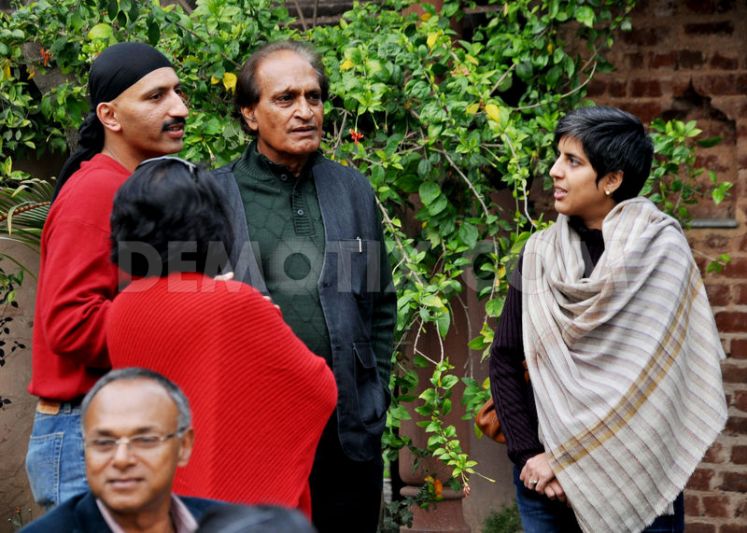
Magnum photographer Raghu Rai inaugurated his photography school, Raghu Rai Center For Photography, along with his son Nitin Rai in New Delhi. People from all parts of the photography community came to wish him well on this occasion.
Runi Khan was working with me on trying to recreate the “Concert for Bangladesh” in Bangladesh.
It was far from easy trying to pull such a massive project together, but this note from Pandit Ravi Shankar made a big difference to us.
Goodbye Raviji. The angels will rejoice in your music.
——-
Dear Olivia
It is coming up to the 40th anniversary of the Birth of Bangladesh and time perhaps to reminisce about our memorable Concert for Bangladesh. The world has changed so much since then, but I hope the spirit that drove George and all of us to rise up as individuals against human rights abuses or to address natural calamities remains strong. I was therefore delighted to have been approached by our dear Bangladeshi friend Runi Khan, requesting us to join and give support to an initiative to re-stage the Concert ?in celebration of the 40th year of the independence of Bangladesh on 16th December 2011.
The intention this time round is to hold the concert in Bangladesh itself, illustrating how much development has taken place since our initiative in 1971. This project is spearheaded by Bangladeshis, Runi? – whom I have known for many years – and Dr Shahidul Alam, both are very respected in the field of events, photography, film and in cultural and social activism.? They have been plotting to celebrate the concert for years for its own sake but want to use the power of the world of artists to send out a strong message once again. I attach their brief treatment outline.
Their vision is to bring together as many of the performers from the original concert – sadly too many are no longer with us. You are our first port of call as you are instrumental in their being able to move forward with this meaningful and ambitious project and making it happen in 2011.? The idea would be to draw in artists also from the contemporary music scene to reach out to newer generations. The concert would be complemented by a documentary looking at the event then and now. More broadly, it will be accompanied by a programme of awareness raising initiatives.
I understand that Sukanya had introduced Runi to you at our concert at the Southbank Centre in London a few years back and Runi I believe had taken the opportunity to very briefly air her thoughts to you. She said she was touched at the time by your spontaneously positive response.
May I suggest that you meet Runi, as she lives in London. Once you understand first hand their concept and objectives please let me now how feel about this and we can take it from there. You will no doubt appreciate that that there will be a lot of logistics that they will need to address to put together an event of this magnitude. Time is of essence and as such an early response from you will allow them to move forward swiftly.
Warmest wishes
Ravi
Congratulatory letter from Raviji about the proposed Dhaka World Music Festival by Runi, and the Concert for Bangladesh that we were planning.
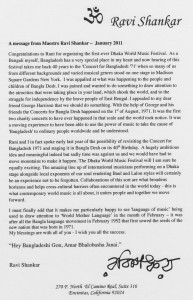
Please Retweet #Bangladesh #ravishankar #sitar #music #concertforbangladesh

“These defendants were found to have engaged in terrorist activities ? These sentences should send a message that when individuals decide to endanger the safety of our community, they will be held to account.”
Dettelbach, however, was trying to spin the judge’s ruling that, in fact, rebuked the government. Dowd handed down far shorter sentences than the prosecutor sought, reportedly saying that the proposed prison terms were “grotesque” and “doesn’t make any sense whatsoever”. The prosecution had asked for sentences of 30, 25 and 19 years, respectively, for Douglas Wright, 27, Brandon Baxter, 20, and Connor Stevens, 20, in the failed plot to use plastic explosives to topple the Route 82 bridge spanning Ohio‘s Cuyahoga Valley National Park on 30 April 2012. Continue reading “Cleveland anarchist bomb plot aided and abetted by the FBI”
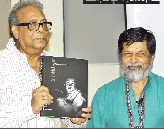
A photography workshop at Indian Council for Cultural Relations (ICCR) redefined photography widening its meaning from an art to a powerful tool for social change. The three day?workshop organised by British Council and Drik India had Shahidul Alam, the eminent photographer and social activist from Bangladesh educating budding photographers of the city on the fine nuances of photography. The documentary photography workshop titled Photography for social impact ? To know, one must imagine was part of British Council?s Active Citizens programme. The workshop was about the right techniques to use camera as a tool for telling a story to create a social impact.
On the first day of the workshop participants were given an introduction to social documentary photography and its impact. It helped participants to interpret and create photographs that would stand out from the crowd and question the objectives of one?s perception and participation in the world we live in. The second day saw the review of the participants? photographs as they learnt the art of editing and presentation.
The concluding day witnessed the release of Shahidul Alam?s book, My Journey as a Witness, in the presence of ace photographer Nemai Ghosh. With the extensive launch session of his book, Alam took us through different pages of his life with the help of photographs. Each picture had an extraordinary story to tell. The stories changed his life at every point and gave momentum to his motto to bring a change in the society. He had been a witness but not a silent one to the changing social and political landscapes of Bangladesh. His photographs also narrated the grim tales of Kashmir and Sri Lanka.
Alam discussed the power of documenting photography and urged the participants and his audience to use it in the right spirit.
—-
Review of “My journey as a witness” by John Morris
Please Retweet:??#Drikbooklaunch